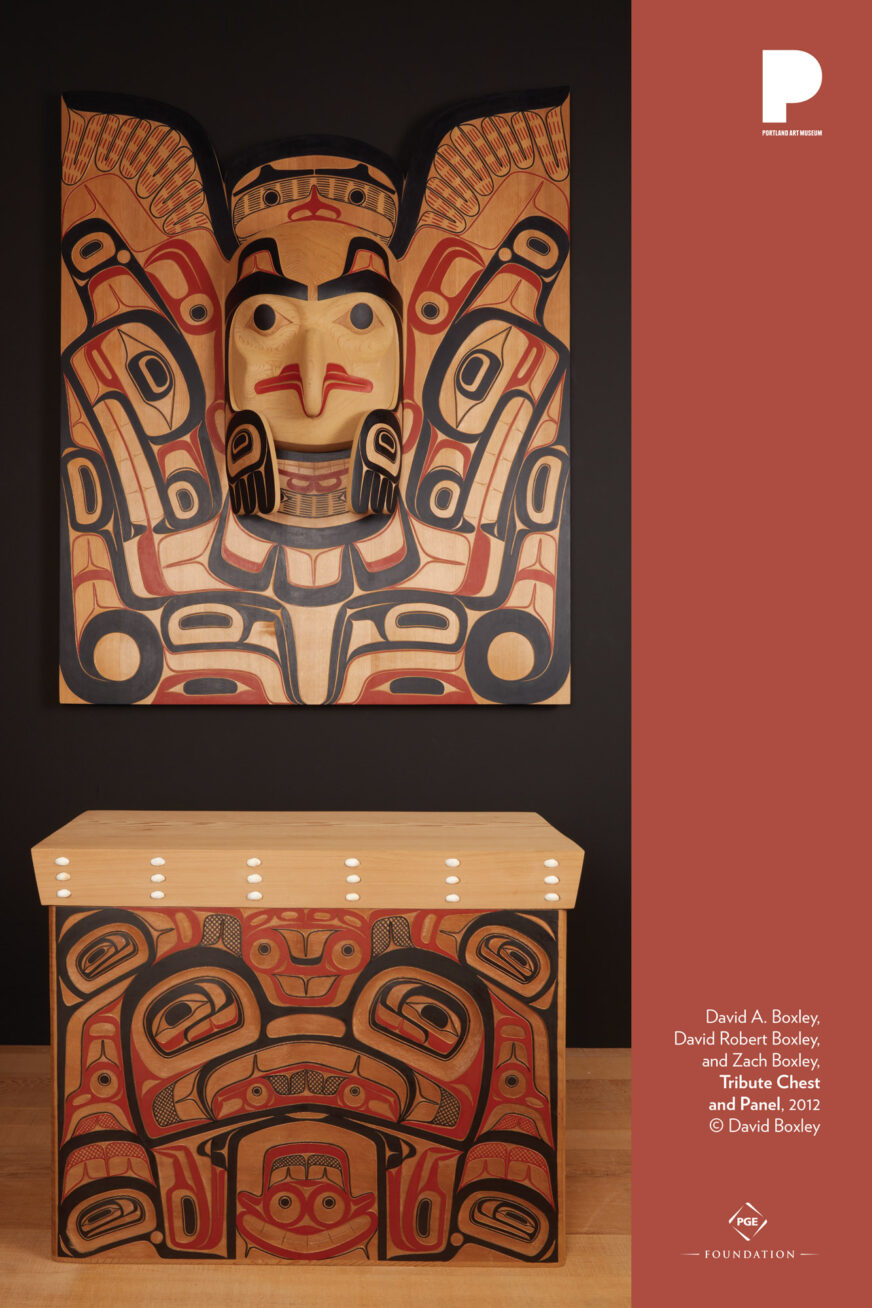
David Boxley is a Tsimshian carver from Metlakatla, Alaska. Tribute is a two-part work comprised of a carved and painted bentwood chest and hanging panel that depict the legacy of Boxley’s family and clan. Historically, Tsimshian and other Northwest Coast Native people created bentwood boxes to hold the most important objects of the family, such as headwear, instruments, and regalia. This spectacular, fully carved bentwood Tribute chest symbolically holds the family itself as the treasure, anchoring the next generation in their family’s culture and history. The work as a whole celebrates the family’s journey—across history, geography, and time—paying tribute to the shared honor, pride, and inherent expectations of the Boxley legacy.
The figures carved on the panel and the sides of the box evoke members of David Boxley’s family: The winged creature at the top of the panel represents Boxley’s grandfather, who was his teacher and mentor. The figure just beneath that one is the eagle, which represents Boxley’s father. On each side of the eagle are wolves to represent Boxley’s sons, David Robert and Zach, who are wolf clan on their mother’s side of the family and who helped create the panel. The bentwood chest is decorated with the family’s clan crests, as well as the symbol of the human hand, which speaks to the importance of handcrafts and art to the family’s legacy.
In the recent rebirth of Native American cultural traditions, artists have become the culture bearers for their tribes. In all of David Boxley’s works of art, from totem poles and box drums to prints, he emphasizes Tsimshian style and his sense of responsibility for bringing the traditions he’s learned as a student and carver back to his home village. Boxley has been deeply involved in the rebirth of Tsimshian culture through organizing and hosting potlatches in Alaska and Washington. Potlatches, yesterday and today, involve traditional cultural activities such as clan adoption, name giving, gift giving, ceremonial regalia dedication, and memorials for people who have passed. Song, dance, and storytelling are an important part of the potlatch ceremony and Boxley contributes to all of these arts. He explains, “I am determined and dedicated to become the finest artist that I can be while at the same time helping to revitalize and carry on the rich culture of my tribe: I want my sons and other young Indian people to be proud of their heritage.”
Boxley has been directly involved in the formation of four successful dance groups: one in his home village of Metlakatla, Alaska, and others in Seattle, Washington. He leads the Git-hoan (People of the Salmon) Native Dance Group. Boxley has written over 40 songs in his Native language and carved many masks, rattles, paddles, and other performance items.
Discussion and activities
- What materials are the Tribute Chest and Panel made of? How do you think they were made?
- David Boxley and his sons are contemporary artists, as you can see from their birth dates in the information above. Why do you think they choose to use traditional Tsimshian materials and techniques in their art?
- Explore the meanings of the words tribute and legacy. Begin by listing as many synonyms and associations for each word as you can think of. How do people create tributes in your culture? Do you have anything in your home that you might call a tribute panel? (Examples could include a wall of photographs, a collection of objects, a family portrait.) If you were to make a tribute panel like this one, which animal would you choose to represent your family?
- Place your finger down on the bottom of the panel or the chest and trace the black line, either right or left, as far as you can without picking up your finger. It is ok to backtrack. What is the importance of the black line, known as a formline, to the design as a whole? What do you think the rounded shapes, or ovoids, represent? What other design elements do you notice?
- Examine the animal designs on the panel. Which shapes or lines indicate the eagle and the wolf? Can you identify eyes, beaks, wings, tails, muzzles, or ears? How do the different shapes relate to each other?
- David Boxley’s father is eagle clan, but his two sons are wolf clan, like their mother. What does this suggest about the organization of Tsimshian families and clans? How would you trace your family’s genealogy? Would you follow lines of descent through women or men? Do you identify a particular parent, grandparent, or ancestor as especially important?
- Find Metlakatla, Alaska, on a map. What can you learn about the natural environment of Metlakatla from the work’s designs and materials?
Sources
- David A. Boxley’s website
- Video: David A. Boxley and the Git-Hoan Dancers demonstrating dance traditions of the Tsimshian people
- Video: David A. Boxley Totem Pole at the National Museum of the American Indian
- The Metlakatla Indian Community
- Marker indicated location of Metlakatla, Alaska – Source

Spanish-language PDFs developed with the support and collaboration of
